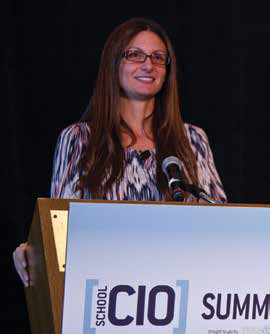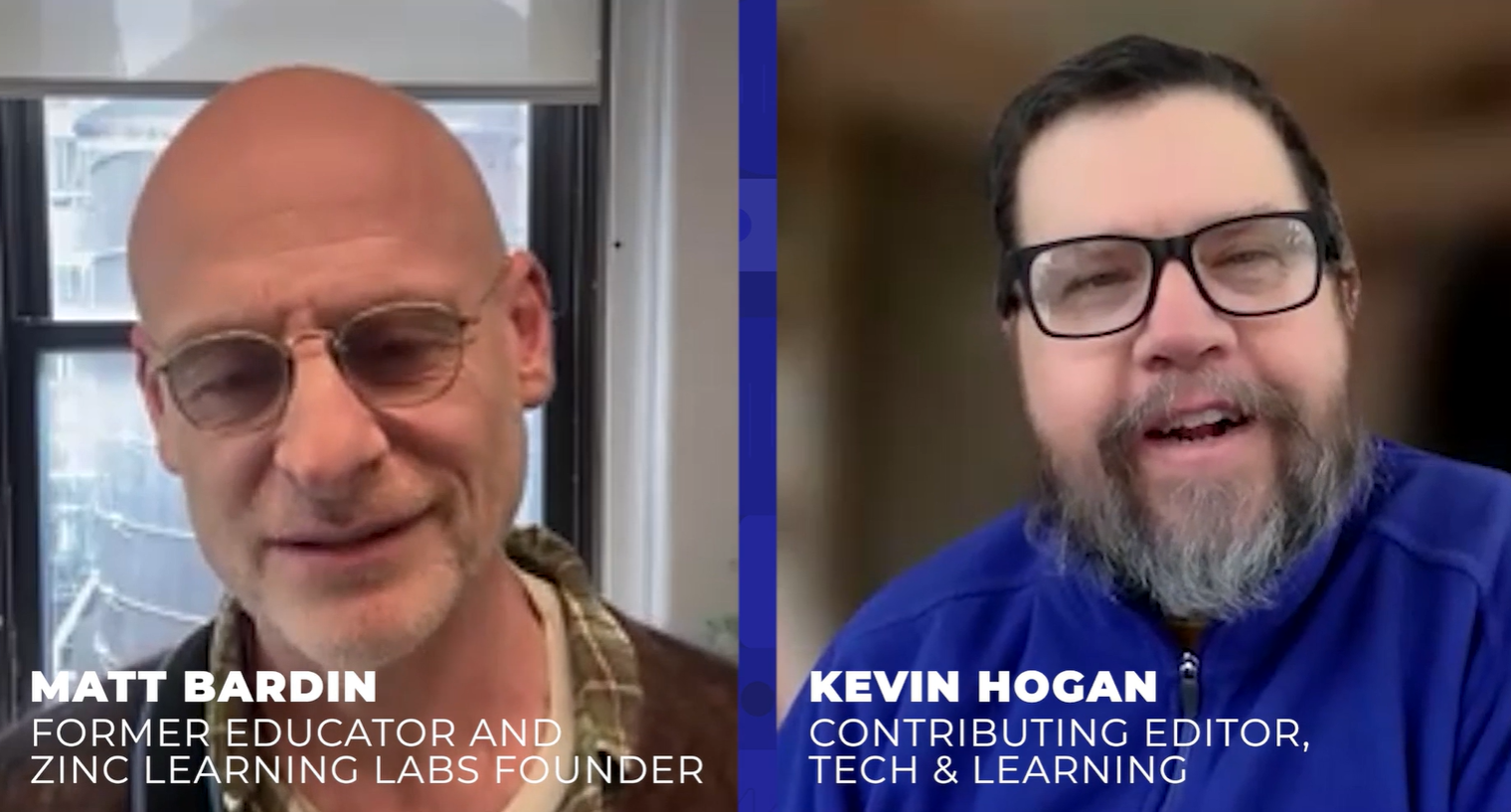BEST OF SCHOOLCIO

Melissa Pelochino, director of professional development, k12 lab network, d.school, Stanford University The CIOs, superintendents, tech directors, and other district-level leaders who attended the SchoolCIO Leadership Summit in San Francisco last October got to do a hands-on session with Melissa Pelochino, director of professional development at the Stanford University Design School. Pelochino talked about design thinking and led the group through a design-thinking workshop.
WHAT IS DESIGN THINKING?
Design thinking is synonymous with human-centered design. According to Pelochino, any product, service, experience, process, system, or ecosystem you are designing or innovating around starts and ends with people. Even though we tend to think about innovation as an epiphany or a one-time event, the design school believes that innovation can come from a five-step process of innovation called design thinking.
THE FIVE-STEP PROCESS
“Having a process for innovation increases the chances of innovation in your districts exponentially,” says Pelochino. “When you have a process and you go through it many, many, many times, you end up moving past the process and into mindsets. This is ultimately what I—as a former teacher and now a teacher’s teacher—care about the most: the mindsets that come from doing a process collaboratively over time.”
Step 1: Empathize. The first phase is where you use research to gain an understanding about whom you’re designing for. You do this by interviewing, observing, and immersing yourself in the experiences of others.
Step 2: Define. This is where you define the problem. Notice that you don’t start the process with a problem; rather, you start with people and then move to a problem that you’re going to solve.
Tools and ideas to transform education. Sign up below.
Step 3: Ideation. Once you identify the problem, it’s ideation time, during which you come up with thousands of ideas to solve that problem. The ideas should run the gamut from wild and crazy to feasible.
Step 4: Prototype. Select some ideas to prototype and test.
Step 5: Test. Share your ideas and get feedback.
DO YOUR OWN MINI-DESIGN CHALLENGE
Summit sponsors fill the tables with tchotchkes. At your next PD session, you can lead your colleagues in a mini-design challenge. Here’s the one Summit attendees did on redesigning the gift-giving experience.

Step 1: Identify someone at your table to partner with and interview your partner for three minutes about gift giving.
Take notes. Here are some questions you might want to ask: What is the last gift you received? What is the last gift you gave? What are some things that make you happy? How do spend your time? You want to discover what delights your partner and you want to ask for specific stories. Switch after three minutes.
Step 2: Dig deeper to get past surface-level information.
The easiest strategy for doing this is by asking why. Look at the information you have written, pick out something that’s of interest to you, and ask your partner to tell you more about why she did that, why he thinks that, or why she feels that way. Each partner gets three minutes to dig deeper about into the partner’s gift-giving experience.
Step 3: This is the interpretation part of the process.
For some people, this is scary because you have to take some risks and make some assumptions and interpretations about the data you collected. Try and capture some needs you believe your partner has regarding gift giving and/or receiving. The needs should be in the form of verbs or verb-like phrases, such as “needs to communicate,” “needs to balance,” or “needs to spend time with.” Complete those sentences phrases and put them on the top of the paper in front of you; on the bottom part is where you will write your insights. What do you think you know about your partner now, based on what he or she shared with you? Spend three minutes to work on this independently. Do not check in with your partner or validate your interpretations.
Step 4: Defining the problem is a critical phase of the design-thinking process.
Based on the needs and the insights you documented in step three, you get to choose the one need you believe your partner has the most. You will write your partner’s name at the top, and write one need from your list and one insight to make a complete need statement.
Step 5: You are transitioning to the third mode of the process, which is to ideate.
In the last step you wrote the problem statement. Now you should come up with 3 to 10—or even more—ideas to solve your partner’s needs or come up with a way to delight your partner. Imagine that you have a million dollars to solve this problem, and don’t think about obvious solutions.
Step 6: Next, you get to share some of your ideas with your partner for feedback.
You are not selling your ideas; you are simply offering them feedback. You are looking for body language and things that excite your partner. You can ask questions like: What would make this better? How can I improve this? Share your idea and get feedback for three minutes and then switch.
Steps 7 and 8: So far, you empathized with your partner by interviewing him or her and digging deeper.
Based on the data you collected, you defined an opportunity or a problem that you could solve or design around. In the last round, you ideated some ideas and shared those for feedback. Based on that feedback, you’re going to select the one idea that you think would delight your partner the most. In seven minutes you’re going to do two things: First, in 30 to 60 seconds, you will sketch that idea or concept. Then, go to the back of the room where you’ll find some low-resolution prototyping materials (i.e., assorted paper, glue sticks, and scissors) and then build your idea or a tangible representation of that idea for your partner.
Congratulations! You have just very quickly gone through the entire arc of the Design School’s process for innovation. You empathized through interviewing, defined an opportunity, came up with several solutions, selected one, built a prototype, and shared it for feedback. Start your membership to SchoolCIO today by clicking here: www.schoolcio.com
Ask a CIO
Q: What is your biggest challenge as a tech director?
A: “Without a doubt, the biggest challenge of a tech director is to create a shared vision and plan in true collaboration with the curriculum/ teaching and learning departments in the school. For too many years, technology and TL have been in two very big, but very separate, silos. And this has served neither department well. For the TL department, it’s meant not taking advantage of the power technology can bring to best
practices like WICOR, RtI, Framework for Teaching, formative assessment, project-based learning, and other initiatives they are striving to embed in classrooms. For the tech department, such departmentalization results in an over emphasis on infrastructure, filtering, and ‘stuff’ that goes under-utilized. The end results is that technology does not have an impact on learning and creates only ‘pockets of wow’ rather than a culture that embraces technology as an effective tool used on a daily basis.
“Too often, leaders in curriculum and teaching and learning don’t know anything about how technology can be used to support best practices (and maybe are happy in this ignorance). We must invite ourselves into their circles and make them primary players on our own technology committees. In any initiative, they need to be our first cohort of leaners.
“Without the collaboration of these educational leaders, we will be simply custodians of wires and boxes, not educators.”
—Doug Johnson, director of technology, Burnsville-Eagan-Savage (MN) ISD 191
